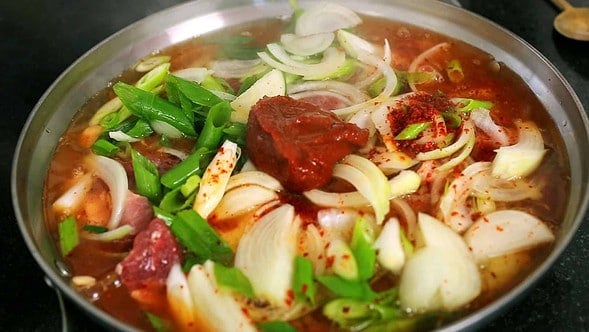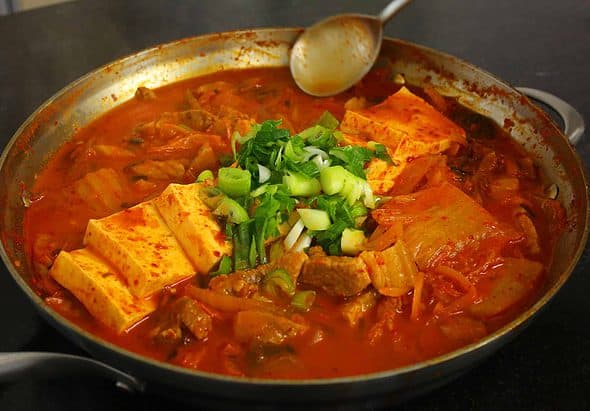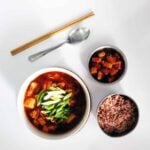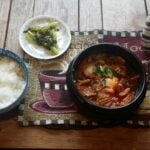Kimchi stew is one of the most-loved of all the stews in Korean cuisine. It’s a warm, hearty, spicy, savory, delicious dish that pretty much everyone loves. As long as they can handle spicy food, I never met a person who didn’t like kimchi-jjigae.
I learned this recipe from a restaurant famous for kimchi-jjigae in Korea. The restaurant was always full of people eating and sweating over kimchi stew. There was only one item on the menu, so everyone was there for the same thing: a steaming pot of spicy kimchi-jjigae, a few side dishes, and a bowl of warm rice. Customers would call out: “Please give me another bowl of rice!”
What really made an impression on me at the time was the fact that they brought the stew out to the table uncooked, and then fired up a burner and cooked it at the table. This way we could sit and talk and watch it cook. I could get a good look at the ingredients: kimchi, onion, green onion, thinly sliced pork on top, and seasonings. There was some white granules (salt, sugar, and probably MSG) and also they used water at the broth base.
From this I developed my own recipe to make at home, which was very delicious.
My kimchi-jjigae recipe served me well for years and years and I even made a video of it in 2007. But since then I developed this version, which is even more delicious. The secret is in the savory anchovy stock.
I hope you make it and enjoy it for years and years to come!
The difference between kimchi soup and kimchi stew
Kimchi stew is thicker than kimchi soup. Kimchi soup is less salty than kimchi stew.
Also, soup is always served in individual bowls, with rice. Traditionally in Korean cuisine stews were served in a big pot on the table, and the family would eat communally from the pot. These days, some people (including me) get a little freaked out by double-dipping, so for stews I put individual bowls on the table, and a large spoon so that diners can take what they like from the pot and put it in their bowls.
Ingredients
(serves 2 with side dishes, serves 4 without)
- 1 pound kimchi, cut into bite size pieces
- ¼ cup kimchi brine
- ½ pound pork shoulder (or pork belly)
- ½ package of tofu (optional), sliced into ½ inch thick bite size pieces
- 3 green onions
- 1 medium onion, sliced (1 cup)
- 1 teaspoon kosher salt
- 2 teaspoons sugar
- 2 teaspoons gochugaru (Korean hot pepper flakes)
- 1 tablespoon gochujang (hot pepper paste)
- 1 teaspoon toasted sesame oil
- 2 cups of anchovy stock (or chicken or beef broth)
For stock (makes about 2½ cups’ worth):
- 7 large dried anchovies, heads and guts removed
- ⅓ cup Korean radish (or daikon radish), sliced thinly
- 4×5 inch dried kelp
- 3 green onion roots
- 4 cups water
Directions
Make anchovy stock:
- Put the anchovies, daikon, green onion roots, and dried kelp in a sauce pan.

- Add the water and boil for 20 minutes over medium high heat.
- Lower the heat to low for another 5 minutes.
- Strain.

Make kimchi stew:
- Place the kimchi and kimchi brine in a shallow pot. Add pork and onion

- Slice 2 green onions diagonally and add them to the pot.
- Add salt, sugar, hot pepper flakes, and hot pepper paste. Drizzle sesame oil over top and add the anchovy stock


- Cover and cook for 10 minutes over medium high heat.

- Open and mix in the seasonings with a spoon. Lay the tofu over top.


- Cover and cook another 10 to 15 minutes over medium heat.
- Chop 1 green onion and put it on the top of the stew. Remove from the heat and serve right away with rice.

Maangchi's Amazon picks for this recipe
It's always best to buy Korean items at your local Korean grocery store, but I know that's not always possible so I chose these products on Amazon that are good quality. See more about how these items were chosen.


























































